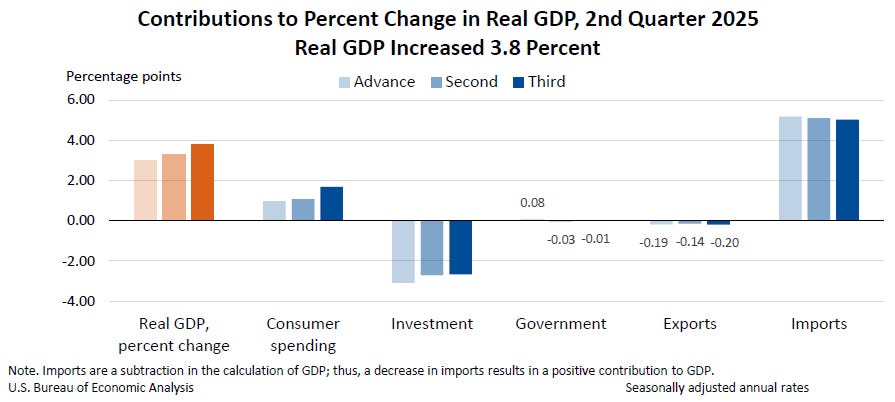Before You Pop the Champagne Corks Over That GDP Report...
GDP for the second quarter was revised higher this morning to an annualized 3.8%, up 0.5% from the last estimate. Most of the improvement over the prior estimate was due to an upward revision in consumer spending.
That’s good!
But before you pop the champagne cork…
Take a look at the chart below.
There’s a lot of moving parts here, but I can keep it simple. Look at the far left side of the chart… and then the far right. You don’t have to be a math whiz to see that literally all economic growth last quarter was due to a decline in imports. Without the massive drop in imports, GDP would have actually shrunk last quarter.
Even the improved consumer spending number contributed less than 2% to GDP growth. And business investment dropped like a rock.
We know why imports fell. Higher tariffs incentivize us to import less. And a lot of companies massively juiced their imports late last year and in the first quarter of this year to get in front of the tariffs. No mystery there.
But this is not growth.
It’s an accounting quirk.
The way GDP is calculated, a decrease in imports increases reported growth, and an increase in imports reduces it.
But let’s think through this. A decline in spending on imports is not a sign of strength unless you see an equally large increase in domestic spending. We’re not seeing that. At all.
We’re also seeing no improvement in exports. The trade war hasn’t exactly made American exports more popular to foreign buyers.
Given the massive shock to the system from the new tariff regime, we should probably view all economic statistics for the next year with a large grain of salt. It really is a new world, so most year-over-year comparisons are meaningless.
But we can also use common sense.
The economy isn’t growing at 3.8%. It’s not growing at anything close to that. That’s not a policy criticism. It’s basic math.
We’ll see what the third quarter report says when it’s released next month. But you’ll want to look past the headline number and focus on consumer spending and business investment.


